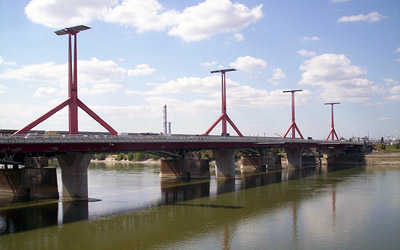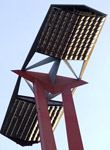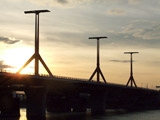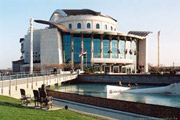Lagymanyosi Bridge
The Lagymanyosi Bridge is the most southern Danube bridge of Budapest. It connects Könyves Kálmán Boulevard to the south Buda district of Lágymányos, after which it has been named.
The Lagymanyosi Bridge was built in 1995 for a planned World exhibition that should have been held jointly by Budapest and Vienna. Although the World exhibition did not take place in the end, the bridge still had been built. Its construction had become necessary for two reasons: on the one hand to discharge the Petofi Bridge, which had been the most southern bridge of Budapest until then, on the other hand to connect the recently built Könyves Kálmán Boulevard and the developing areas of the Buda side.

Lagymanyosi Bridge is the most southern Danube bridge of Budapest
The construction of the steel girder bridge was started in 1992 to the plans of Tibor Sigrai. Lagymanyosi Bridge is supported by three river piers, which have been built directly next to the massive ironwork of the Southern Connecting Railway Bridge. Its inauguration took place on 30 October 1995. With the construction of Lagymanyosi Bridge, its surroundings also started a rapid development. Initially, the bridge should have been named after celebrated Hungarian actor Zoltán Latinovits, the names Szent László Bridge, Kossuth Bridge, Szent István Bridge, King Mátyás Bridge and Peace Bridge also came into discussion. Eventually, it was christened after the south Buda district Lágymányos.
 Unique lighting system |
The bridge is 493.4 meters long and 30.5 meters wide. Its most interesting feature is the unique lighting system. The bridge contains five columns, on top of which two mirrors each are to be found. These are illuminated by high-performance halogen reflectors placed below, and from a height of 35 meters, they disperse the light evenly on the roadway. The pavement and cycle path on the northern side of the bridge and also the barriers are illuminated with the help of neon tube machines.
 Lagymanyosi Bridge at sunset |
At the northern part of the bridge, at both the Pest and the Buda ends, there are memorial stones with the following engraving: "Lagymanyosi Bridge. Built between 1992 and 1995 by a common initiative of the Government of the Republic of Hungary proclaimed in 1989 and the Local Authority of Budapest as the last part of the Hungária Boulevard to promote the development of the city system and the transport in Budapest."
 Hungarian National Theatre |
The modern building of the National Theatre built in a record time of 15 months to the plans of architect Mária Siklós is situated at the Pest end of the bridge. It opened its gates on 15 March 2002. In the surrounding area, a nice park has been established.
The Palace of Arts, inaugurated on 14 March 2005, is situated directly next to the National Theatre. The plans had been made by Gábor Zoboki, who had cooperated with quite a few other designers to develop the detailed drafts. One part of the complex overlooking the Danube hosts the Ludwig Museum - Museum for Contemporary Art, the only museum in Hungary containing only pieces of contemporary art and disposing of major international and Hungarian fine arts collections.
|
||||||||||||||
|
External links
- National Theatre - The Hungarian National Theatre
- The Palace of Arts - A relatively new cultural complex with concert hall
- Ludwig Museum - Museum of Contemprary Art
BRIDGES OF BUDAPEST
DID YOU KNOW?
The Neo-Renaissance building of the Hungarian Academy of Sciences, inaugurated in 1865, can be found at Roosevelt Square, at the Pest end of Chain Bridge.Read more


